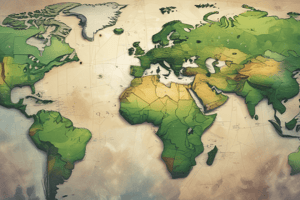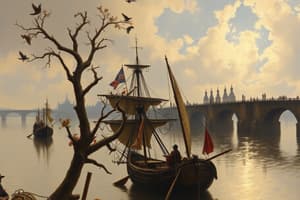Podcast
Questions and Answers
During the early 1500s, what did countries pursue in terms of global connectivity?
During the early 1500s, what did countries pursue in terms of global connectivity?
What characterized the scale and volume of interconnectivity by the beginning of the 20th Century?
What characterized the scale and volume of interconnectivity by the beginning of the 20th Century?
By 1910, which countries had control over India, Africa, and Southeast Asia?
By 1910, which countries had control over India, Africa, and Southeast Asia?
What happened to China, Central and South America, and the Ottoman Empire during the period of globalization at the start of 1900?
What happened to China, Central and South America, and the Ottoman Empire during the period of globalization at the start of 1900?
Signup and view all the answers
What was a common material used in the mixed-media assemblages of Dadaism artists?
What was a common material used in the mixed-media assemblages of Dadaism artists?
Signup and view all the answers
What was the concept behind the Bauhaus design?
What was the concept behind the Bauhaus design?
Signup and view all the answers
What was the main focus of Synthetic Cubism?
What was the main focus of Synthetic Cubism?
Signup and view all the answers
What influenced the subconscious art of Surrealism?
What influenced the subconscious art of Surrealism?
Signup and view all the answers
What was a key aspect of the social art of Harlem Renaissance?
What was a key aspect of the social art of Harlem Renaissance?
Signup and view all the answers
What did Synthetic Cubism artists initially focus on instead of color?
What did Synthetic Cubism artists initially focus on instead of color?
Signup and view all the answers
What did Dadaism artists challenge through their art?
What did Dadaism artists challenge through their art?
Signup and view all the answers
What was a key aspect of Bauhaus education workshops?
What was a key aspect of Bauhaus education workshops?
Signup and view all the answers
What was a significant result of Bauhaus design concepts?
What was a significant result of Bauhaus design concepts?
Signup and view all the answers
What was a key influence on the artists involved in Harlem Renaissance?
What was a key influence on the artists involved in Harlem Renaissance?
Signup and view all the answers
How did Surrealists believe creativity grew from the subconscious?
How did Surrealists believe creativity grew from the subconscious?
Signup and view all the answers
What did European countries export during the 20th century, leading to competition in various fields?
What did European countries export during the 20th century, leading to competition in various fields?
Signup and view all the answers
What led to significant upheavals worldwide as declining countries struggled to industrialize and compete globally?
What led to significant upheavals worldwide as declining countries struggled to industrialize and compete globally?
Signup and view all the answers
Which regions dominated the global GDP during the 20th century?
Which regions dominated the global GDP during the 20th century?
Signup and view all the answers
What impact did rapid economic and industrial growth have during the 20th century?
What impact did rapid economic and industrial growth have during the 20th century?
Signup and view all the answers
What were the major events of the first half of the 20th century that led to significant global power redistribution?
What were the major events of the first half of the 20th century that led to significant global power redistribution?
Signup and view all the answers
What impact did World War I have on social norms and world order?
What impact did World War I have on social norms and world order?
Signup and view all the answers
What ideology destabilized the world order during World War II?
What ideology destabilized the world order during World War II?
Signup and view all the answers
What impact did the chaos of the time have on the art world during the 20th century?
What impact did the chaos of the time have on the art world during the 20th century?
Signup and view all the answers
What was the focus of modernism in art during the 20th century?
What was the focus of modernism in art during the 20th century?
Signup and view all the answers
What were the three new courses of art that emerged at the beginning of the 20th century?
What were the three new courses of art that emerged at the beginning of the 20th century?
Signup and view all the answers
How did Fauvism convey meaning through its use of color?
How did Fauvism convey meaning through its use of color?
Signup and view all the answers
Study Notes
20th Century Globalization, Wars, and Art Movements
- European countries exported their social cultures and sciences, leading to competition in industry, technology, architecture, and scientific concepts.
- Declining countries struggled to industrialize and compete globally, leading to significant upheavals worldwide.
- The industrialized regions of Europe, North America, the USSR, and Japan dominated the global GDP, while the United States and the USSR emerged as conflicting power blocs.
- Rapid economic and industrial growth led to environmental destruction, while rising economies and nationalist movements weakened Europe's control and influence.
- The first half of the 20th century saw two world wars, a great depression, and significant global power redistribution.
- World War I brought about a breakdown in social norms, changing class structures, and fragmented world order, leading to nationalist movements and revolutions in various countries.
- World War II and Hitler's ideology of Nazism and fascism further destabilized the world order, leading to widespread destruction.
- The chaos of the time led to a shift in the art world, with artists experimenting and innovating, developing new modes of expression based on personal experiences.
- Modernism in art detached from reproduction and focused on the basic elements of line, color, and dimension, resulting in multiple new styles and movements.
- The beginning of the 20th century brought three new courses of art: expression, fantasy, and abstraction, with a range from realistic to non-representational works.
- Fauvism rejected the pastel palette, using bold, unnatural colors and fragmented shapes to convey meaning and movement, defying academic painting standards.
- Cubism reconstructed subjects into geometric shapes or abstraction, with Analytic Cubism overlapping frontal surfaces in linear grids.
Studying That Suits You
Use AI to generate personalized quizzes and flashcards to suit your learning preferences.
Description
Test your knowledge about the historical advancement of globalization and its impact on economic, cultural, and political interconnectivity across the world.




